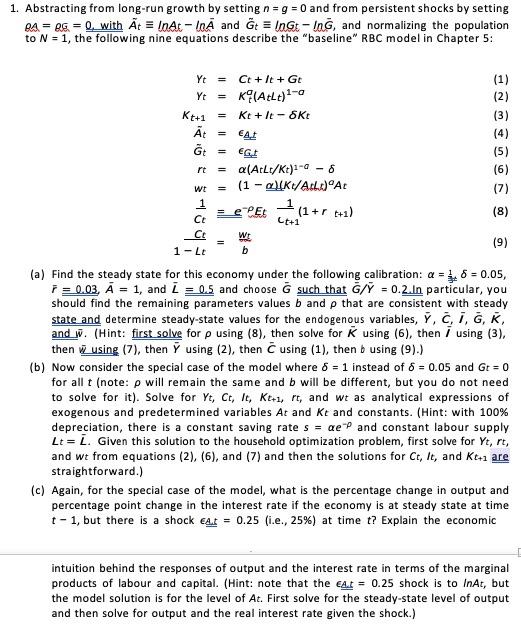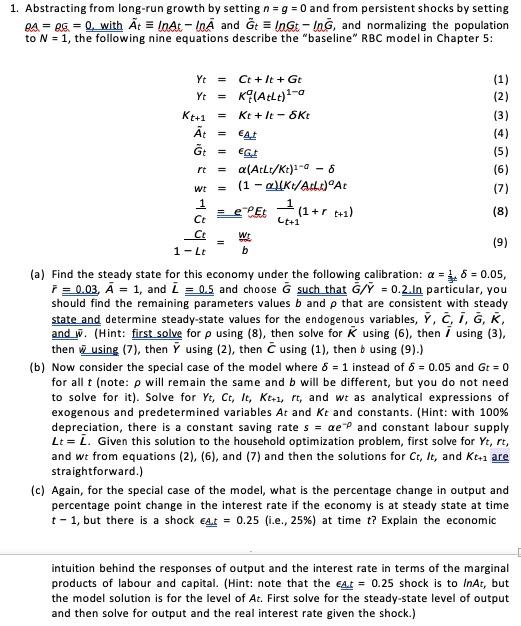1. Abstracting from long-run growth by setting n=g=0 and from persistent shocks by setting QA=QG=0, with A~tlnAtnA and G~tlnGtlnG, and normalizing the population to N=1, the following nine equations describe the "baseline" RBC model in Chapter 5 : YtYtKt+1At~Gt~rtwt1CLtCt=Ct+It+Gt=Kta(AtLt)1a=Kt+ItKt=At=Gt=(AtLt/Kt)1a=(1)(Kt/Atbt)aAt=eEtCt+11(1+rtt+1)=bWt (a) Find the steady state for this economy under the following calibration: =31=0.05, r0.03,A=1, and L0.5 and choose G such that G/Y=0.2.In particular, you should find the remaining parameters values b and that are consistent with steady state and determine steady-state values for the endogenous variables, Y,C,I,G,K, and w. (Hint: first solve for using (8), then solve for K using (6), then l using (3), then w using (7), then Y using (2), then C using (1), then b using (9).) (b) Now consider the special case of the model where =1 instead of =0.05 and Gt=0 for all t (note: will remain the same and b will be different, but you do not need to solve for it). Solve for Yt,Ct,lt,Kt+1,rt, and wt as analytical expressions of exogenous and predetermined variables At and Kt and constants. (Hint: with 100% depreciation, there is a constant saving rate s=e and constant labour supply Lt=L. Given this solution to the household optimization problem, first solve for Yt,rt, and wt from equations (2), (6), and (7) and then the solutions for Ct, tt, and Kt+1 are straightforward.) (c) Again, for the special case of the model, what is the percentage change in output and percentage point change in the interest rate if the economy is at steady state at time t1, but there is a shock A,t=0.25( i.e., 25\%) at time t ? Explain the economic intuition behind the responses of output and the interest rate in terms of the marginal products of labour and capital. (Hint: note that the A.t=0.25 shock is to InAt, but the model solution is for the level of At. First solve for the steady-state level of output and then solve for output and the real interest rate given the shock.) 1. Abstracting from long-run growth by setting n=g=0 and from persistent shocks by setting QA=QG=0, with A~tlnAtnA and G~tlnGtlnG, and normalizing the population to N=1, the following nine equations describe the "baseline" RBC model in Chapter 5 : YtYtKt+1At~Gt~rtwt1CLtCt=Ct+It+Gt=Kta(AtLt)1a=Kt+ItKt=At=Gt=(AtLt/Kt)1a=(1)(Kt/Atbt)aAt=eEtCt+11(1+rtt+1)=bWt (a) Find the steady state for this economy under the following calibration: =31=0.05, r0.03,A=1, and L0.5 and choose G such that G/Y=0.2.In particular, you should find the remaining parameters values b and that are consistent with steady state and determine steady-state values for the endogenous variables, Y,C,I,G,K, and w. (Hint: first solve for using (8), then solve for K using (6), then l using (3), then w using (7), then Y using (2), then C using (1), then b using (9).) (b) Now consider the special case of the model where =1 instead of =0.05 and Gt=0 for all t (note: will remain the same and b will be different, but you do not need to solve for it). Solve for Yt,Ct,lt,Kt+1,rt, and wt as analytical expressions of exogenous and predetermined variables At and Kt and constants. (Hint: with 100% depreciation, there is a constant saving rate s=e and constant labour supply Lt=L. Given this solution to the household optimization problem, first solve for Yt,rt, and wt from equations (2), (6), and (7) and then the solutions for Ct, tt, and Kt+1 are straightforward.) (c) Again, for the special case of the model, what is the percentage change in output and percentage point change in the interest rate if the economy is at steady state at time t1, but there is a shock A,t=0.25( i.e., 25\%) at time t ? Explain the economic intuition behind the responses of output and the interest rate in terms of the marginal products of labour and capital. (Hint: note that the A.t=0.25 shock is to InAt, but the model solution is for the level of At. First solve for the steady-state level of output and then solve for output and the real interest rate given the shock.)








